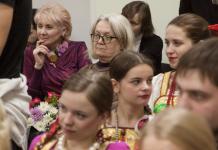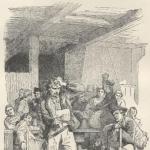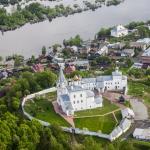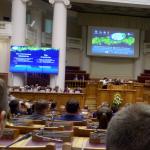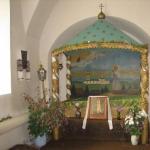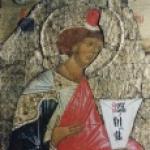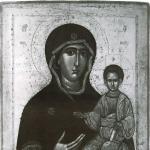The leading folklorist of the region, Nelly Novoselova, told the guests of the Kasyanovsky House about the importance of folk art.
The evening of December 14 will be special for the Kasyanov House: I understood this even before the meeting with Nelly Aleksandrovna Novoselova, Candidate of Philological Sciences, Associate Professor of the Department of World Literature and Methods of Teaching it at the Krasnoyarsk State Pedagogical University. V.P. Astafiev, the author of many monographs and publications, an excellent student of public education, an honorary worker of higher professional education in Russia.
The temporary shelter of our museum and educational center - the media center of the Department for Church Relations with Society and the Media of the Krasnoyarsk Diocese - could barely accommodate everyone who wanted to meet the main character of the evening on the eve of her anniversary.
Young people clearly predominated among them.
- Are you Nelly Alexandrovna’s students?
- No, she will start teaching classes next semester.
- Why were you so interested in meeting her?
- That’s how senior students praise her! All! They say he is the best teacher.
Agree that such unanimity among students is in itself indicative. However, Nelly Novoselova is not only an excellent teacher, but also the largest specialist in folklore in the Krasnoyarsk Territory, and no one could have explained the stated theme of the evening better than her.
“Folklore has become my calling”
However, Nelly Alexandrovna might not have become a folklorist,” the host, chief custodian of the Kasyanov House, head of the Diocesan Department for Relations of the Church with Society and the Media, Gennady Malashin, begins the evening with an unexpected biographical detail.
Indeed, Nelly Novoselova began her studies at the Polytechnic Institute, in the radio electronics department. I got in after surviving a difficult competition, but...
“During my studies, I realized that this was not my path at all, that I entered there simply out of interest. Both the dean and my relatives tried to stop me, but I’m glad that I managed to show firmness and leave... My calling turned out to be philology, and specifically folklore.
It is difficult to describe all of Nelly Alexandrovna’s services to her alma mater: she not only educated entire generations of grateful students, but also became the inspirer and main organizer of the creation of a folklore office at her faculty, and expeditions to collect samples of folk art in remote areas of the Krasnoyarsk Territory.
The first such trips took place, as they say, at random, Nelly Alexandrovna now recalls: there was no simple method for surveying local residents, much had to be achieved empirically.

- Our students played a big role: responsible, patient, infinitely friendly: they traveled to distant lands and knocked on the door of these closed, seemingly stern grandmothers from somewhere in the Kezhemsky or Pirovsky district.
Success was achieved: priceless examples of a bygone culture with a long history were preserved for posterity, despite all the artificial obstacles that folklorist enthusiasts encountered in the 70s and 80s of the last century. Saved in a timely manner: nowadays in those places it is already difficult to hear traditional songs or “spells” from those living today...
The depths of history - in the lines of songs
So is it possible to revive the old everyday customs of yesteryear? Popularize the songs that generations of our ancestors sang? To put it simply: is it possible to make folklore accessible to a mass audience, and not to a relatively small circle of connoisseurs and enthusiasts?
The heroine of the evening herself is very skeptical:
- Folklore is a living organism; it is closely connected with everyday life, with people’s beliefs, their ideas about the world around them. As time changes, the content of ritual elements also changes, and aesthetic ideas change.
In the 19th and especially in the 20th centuries, there was a breakdown in the mass consciousness, complains Nelly Alexandrovna. And works of folk culture, closely related to the traditional calendar of agricultural work, full of metaphors and allegorical meaning, suddenly turned out to be incomprehensible and unclaimed by descendants.
But does this mean that Russian folklore in the 21st century is something completely uninteresting and unnecessary, comparable to the dead language of a disappeared people on the other side of the globe?

Absolutely not, the specialist is convinced, explaining: first you need to understand that the term “Russian folklore” itself is very conditional and collective; Even within the Krasnoyarsk Territory, serious differences can be noted in works on the same topic, for example, about family life.
The classic song plot for residents of Central Siberia about how a mother-in-law harasses her daughter-in-law is unknown among Siberians. Why? Yes, because in our lands, with their sparse population and the predominance of the male share of the population for a long time, a respectful attitude towards women has naturally developed. That’s why girls in Siberian families were traditionally married off later, and it was customary to watch their marital happiness more closely than in the European part of Russia...
It is the study of folklore that makes it possible to directly come into contact with the life and customs of a past era. In addition, in our post-industrial age, people have a stronger need to search for roots, to express themselves through their ancestors... That, perhaps, is why advertisements for the same traditional-style weddings appear on city streets? So we can rightfully hope for the awakening of widespread interest in folklore.
Mentor for generations
This idea was voiced in one of the videos recorded by the Kasyanovsky House staff especially for this evening, about Nelly Alexandrovna’s conversation with students.
By the way, the theme of the relationship between the teacher and his students ran like a dotted line throughout the entire evening. Rich teaching experience allowed Nelly Novoselova to make an interesting observation:
- The soul of the people can be traced in every detail. For example, the Russian people are very creative and inventive. Try letting our students rewrite the text: no one will rewrite it word for word! Everyone will change something, correct something.
Even more interesting was the following remark from the heroine of the evening:
- Over the years, you notice that it is not the successful students who are more grateful to you as a teacher, but precisely those who have passed tests and exams many times.
And it is not surprising that it was Nelly Alexandrovna’s current students who were given the honor at the evening, albeit “remotely,” from the screen to congratulate their mentor on the upcoming anniversary. They noted everything: the depth of erudition, the skill of presenting material, the high human qualities, and spiritual richness of the honored teacher and philologist-folklorist.

The folk ensemble “Primrose”, which was present at the event, took over the baton from the students. Its members and participants congratulated Nelly Alexandrovna in the most appropriate manner for the evening: with a festive round dance, and even with singing in the Angara style, so dear to the hero of the day.
The culmination of the honoring of Nellie Alexandrovna was the presentation of the Bishop’s Certificate from Metropolitan Panteleimon of Krasnoyarsk and Achinsk - for his great personal contribution to the development and popularization of spiritual culture in the Krasnoyarsk region.
The honorary award was presented to the teacher by a former student, Gennady Malashin, who also presented her with a copy of the author’s monograph “Krasnoyarsk (Yenisei) Diocese of the Russian Orthodox Church: 1861–2011,” emphasizing that without the lessons received from the teacher at one time, this book would not have been written.
An hour and a half of live communication with an intelligent, highly educated person who is sacrificially in love with his work is an inexhaustible source of food for the mind for many subsequent days, months and, perhaps, even years. As the candidate of philological sciences, associate professor, dean of the philological faculty of the Krasnoyarsk State Pedagogical University named after A. V.P. Astafieva Tatyana Sadyrina: “Nelly Alexandrovna is an amazing person. Communicating with her even for many years, you always learn something new about things that seem to have been known for a long time.”
























The project is being implemented using subsidies from the budget of the Krasnoyarsk Territory with the support of the youth policy agency and the implementation of social development programs in the Krasnoyarsk Territory.
Literature is the art of words. But there is another type of verbal art - oral folk art (oral literature, oral literature), or folklore. Folklore has specific features that fiction does not have. The first chapter is devoted to their consideration.
1. Folklore and folkloristics
The international term "folklore" appeared in England in the mid-19th century. It comes from English. folk-lore (“folk knowledge”, “folk wisdom”) and denotes folk spiritual culture in varying degrees of its types.
Folklore is the subject of study of various sciences. Folk music is studied by musicologists, folk dances by choreographers, rituals and other spectacular forms of folk art by theater experts, folk decorative and applied arts by art historians. Linguists, historians, psychologists, sociologists and other scientists turn to folklore. Each science sees in folklore what interests it. The role of ethnology (from the Greek ethnos: “people” + logos: “word, teaching”), a science that pays a lot of attention to people’s life, is especially significant.
For philologists, folklore is important as the art of words. Philological folkloristics studies the totality of oral works of art of various genres created by many generations of people.
Folk verbal creativity was kept in the memory of people; in the process of communication, works passed from one to another and were not written down. For this reason, folklorists must engage in so-called “field work” - go on folklore expeditions to identify performers and record folklore from them. Recorded texts of oral folk works (as well as photographs, tape recordings, diary notes of collectors, etc.) are stored in folklore.
lore archives. Archival materials can be published, for example, in the form of folklore collections.
When a folklorist engages in the theoretical study of folklore, he uses both published and archival recordings of folk works.
2. Specifics of folklore
Folklore has its own artistic laws. The oral form of creation, distribution and existence of works is the main feature that gives rise to the specificity of folklore and causes its difference from literature.
2.1. Traditionality
Folklore is mass creativity. Works of literature have an author, works of folklore are anonymous, their author is the people. In literature there are writers and readers, in folklore there are performers and listeners.
Oral works were created according to already known models, and even included direct borrowings. The speech style used constant epithets, symbols, comparisons and other traditional poetic devices. Works with a plot were characterized by a set of typical narrative elements and their usual compositional combination. In the images of folklore characters, the typical also prevailed over the individual. Tradition required the ideological orientation of the works: they taught goodness and contained the rules of human behavior in life.
The general thing in folklore is the main thing. Storytellers (performers of fairy tales), singers (performers of songs), storytellers (performers of epics), voplenitsy (performers of lamentations) sought first of all to convey to listeners what was in keeping with tradition. The repeatability of the oral text allowed for its changes, and this allowed an individual talented individual to express himself. A multiple creative act, co-creation, took place, in which any representative of the people could be a participant.
The development of folklore was facilitated by the most talented people endowed with artistic memory and creative gifts. They were well known and appreciated by those around them (remember I. S. Turgenev’s story “The Singers”).
The oral artistic tradition was the common fund. Each person could select for himself what he needed.
In the summer of 1902, M. Gorky observed in Arzamas how two women - a maid and a cook - composed a song (the story “How they composed a song”).
“It was in a quiet street of Arzamas, before evening, on a bench at the gate of the house in which I lived. The city was dozing in the hot silence of June everyday life. I, sitting by the window with a book in my hands, listened to how my cook, the portly, pockmarked Ustinya, talking quietly with the maid<...>Suddenly Ustinya speaks smartly, but in a businesslike manner: “Okay, Mangutka, give me a hint...” - “What is this?” - “Let’s put together a song...” And, sighing noisily, Ustinya begins to sing quickly:
"Oh, yes, on a white day, in the clear sun,
On a bright night, during the month..."
Hesitantly feeling for the melody, the maid timidly sings in a low voice:
"I'm worried, a young girl..."
And Ustinya confidently and very, touchingly brings the melody to the end:
"My heart is always aching..."
Krivokoneva Alisa
Montessori center “Yourself with a mustache”, Nizhny Novgorod
Montessori is a teacher.
Russian folklore for children
Russian folklore for children - what is it?
Russian folklore is a special branch of the culture of the people, which reflects the ideals and life of the Russian people, passed on from generation to generation. Russian folklore is a rich source of a wide variety of educational material, which is distinguished by its colorfulness and originality, along with accessibility, which ensures undying interest for children and easy memorability.
Russian folklore for children - a touch of tradition
Now more and more people are coming to the realization that happiness and success are not across the seven seas. The words Motherland and Fatherland no longer sound like empty words. We are once again regaining a sense of community and pride from belonging to the united Russian people. In this regard, we are restoring and beginning to take a new approach to the heritage of Russian culture, ancient customs and festivals, artistic crafts and applied arts. Studying Russian folklore with children allows you to instill a love for your native culture from childhood, as well as convey inherent ideas about eternal values: goodness and justice, beauty and loyalty, courage and hard work, which are reflected in oral folk art. Proverbs and sayings carry the wisdom of the Russian people accumulated over centuries, which children absorb easily and with pleasure thanks to the brightness and imagery of Russian folklore, as well as the joy that it carries within itself.
Russian folklore for children is an exceptional value for a child’s development
The benefits of Russian folklore classes for children's development are difficult to fully assess. Let's try to list just a few of them:
Classes in Russian folklore develop artistic taste in children
Develops interest in the surrounding world and the fundamentals of existence (change of seasons, mysteries of the animal world, patterns and natural phenomena, etc.)
Allows you to appreciate the richness of the Russian language and culture, and also promotes speech development thanks to a variety of rhymes, sayings, songs and tongue twisters
Riddles and puzzles lay the foundation for creative imaginative thinking
Outdoor games promote harmonious physical development.
Russian folklore for children is a touch to the roots that gives joy!
Russian folklore in kindergarten not only provides an idea of Russian culture, but also gives a sea of positive emotions! We invite our students to experience the history and traditions of their native country during entertaining games and gatherings under the guidance of a delightful teacher who recreates the atmosphere and decor of Russian villages, taking children on an exciting journey through the vast expanses of Russian folklore! Entertaining games that were previously known to any village boy, gatherings with tea and bagels at the samovar, riddles and poems, playing wooden spoons and other folk art instruments - all this and much more will give your child a love for his native culture and belonging to its origins !
Literature is the art of words. But there is another type of verbal art - oral folk art (oral literature, oral literature), or folklore. Folklore has specific features that fiction does not have. The first chapter is devoted to their consideration.
1. FOLKLORE AND FOLKLORISTICS
The international term "folklore" appeared in England in the mid-19th century. It comes from English. folk-lore (“folk knowledge”, “folk wisdom”) and denotes folk spiritual culture in varying degrees of its types.
Folklore is the subject of study of various sciences. Folk music is studied by musicologists, folk dances by choreographers, rituals and other spectacular forms of folk art by theater experts, and folk arts and crafts by art historians. Linguists, historians, psychologists, sociologists and other scientists turn to folklore. Each science sees in folklore what interests it. The role of ethnology (from the Greek ethnos: “people” + logos: “word, teaching”) is especially significant - a science that pays a lot of attention to people’s life 1 .
For philologists, folklore is important as the art of words. Philological folkloristics studies the totality of oral works of art of various genres created by many generations of people.
Folk verbal creativity was kept in the memory of people; in the process of communication, works passed from one to another and were not written down. For this reason, folklorists must engage in so-called “field work” - go on folklore expeditions to identify performers and record folklore from them. Recorded texts of oral folk works (as well as photographs, tape recordings, diary notes of collectors, etc.) are stored in folklore.
1 Previously, this science was called ethnography. Both terms (ethnology and ethnography) are used interchangeably.
lore archives. Archival materials can be published, for example, in the form of folklore collections.
When a folklorist engages in the theoretical study of folklore, he uses both published and archival recordings of folk works.
2. SPECIFICITY OF FOLKLORE
Folklore has its own artistic laws. The oral form of creation, distribution and existence of works is the main feature that gives rise to the specificity of folklore and causes its difference from literature.
2L. Traditionality
Folklore is mass creativity. Works of literature have an author, works of folklore are anonymous, their author is the people. In literature there are writers and readers, in folklore there are performers and listeners.
Oral works were created according to already known models, and even included direct borrowings. The speech style used constant epithets, symbols, comparisons and other traditional poetic devices. Works with a plot were characterized by a set of typical narrative elements and their usual compositional combination. In the images of folklore characters, the typical also prevailed over the individual. Tradition required the ideological orientation of the works: they taught goodness and contained the rules of human behavior in life.
The general thing in folklore is the main thing. Storytellers(performers of fairy tales), singers(song performers), storytellers(performers of epics), screamers(performers of lamentations) sought first of all to convey to the listeners what was in accordance with tradition. The repeatability of the oral text allowed for its changes, and this allowed an individual talented individual to express himself. A multiple creative act took place, co-creation, in which any representative of the people could be
participant.
The development of folklore was facilitated by the most talented people, endowed with artistic memory and creative gifts. They were well known and appreciated by those around them (remember I. S. Turgenev’s story “The Singers”).
The oral artistic tradition was the common fund. Each person could select for himself what he needed.
In the summer of 1902, M. Gorky observed in Arzamas how two women - a maid and a cook - composed a song (the story “How they composed a song”).
“It was in a quiet street of Arzamas, before the evening, on a bench near the gate of the house in which I lived. The city was dozing in the hot silence of June everyday life. I, sitting by the window with a book in my hands, listened as my cook, the portly, pockmarked Ustinya, quietly talking to the maid<...>Suddenly Ustinya speaks smartly, but in a businesslike manner: “Okay, Mashutka, give me a hint...” - “What is this?” - “Let’s put together a song...” And, sighing noisily, Ustinya begins to sing quickly:
"Oh, yes, on a white day, in the clear sun,
On a bright night, during the month..."
Hesitantly feeling for the melody, the maid timidly sings in a low voice:
"I'm worried, a young girl..."
And Ustinya confidently and very touchingly brings the melody to the end:
"My heart is always aching..."
She finished and immediately spoke cheerfully, a little boastfully: “So it has begun, the song! I, my dear, will teach you how to put together songs like how to twist a thread... Well...” After a pause, as if listening to the mournful moans of frogs, the lazy ringing bells, she again deftly played with words and sounds:
"Oh, the blizzards are fierce in winter,
No cheerful streams in spring..."
The maid, moving closer to her, ... now more boldly, in a thin, trembling voice, continues:
"They don't report from their native side
Comforting news to my heart..."
“That’s it!” said Ustinya, slapping her hand on her knee. “And when I was younger, I could write even better songs! Sometimes my friends would pester me: “Ustyusha, teach me a song!” Oh, and I’ll burst into song!.. Well, how what will happen next?" “I don’t know,” said the maid, opening her eyes and smiling.<...>
"The lark sings over the fields,
The cornflowers bloomed in the fields,"
Ustinya sings thoughtfully, folding her hands on her chest, looking at the sky, and the maid echoes smoothly and boldly:
“I should like to look at my native fields!”
And Ustinya, skillfully maintaining a high, swaying voice, spreads soulful words like velvet:
"I'd like to take a walk through the woods with my dear friend!"
Having finished singing, they are silent for a long time..., then the woman says quietly, thoughtfully: “Did they compose the song poorly? It’s really good after all” 1 .
1 Gorky M. Collection cit.: In 30 volumes - T. 11. - M., 1951. - P. 290-293.
Not everything newly created was preserved in oral history. Repeatedly repeated fairy tales, songs, epics, proverbs and other works passed “from mouth to mouth, from generation to generation.” On this path, they lost what bore the stamp of individuality, but at the same time they identified and deepened what could satisfy everyone. The new was born only on a traditional basis, and it had to not just copy tradition, but complement it.
Folklore appeared in its regional modifications: folklore of central Russia, the Russian North, folklore of Siberia, Don folklore, etc. However, local specifics always had a subordinate position in relation to the general Russian properties of folklore.
In folklore, a creative process constantly took place, which supported and developed the artistic tradition.
With the advent of written literature, folklore began to interact with it. Gradually, the influence of literature on folklore increased more and more.
The oral creativity of a people embodies its psychology (mentality, disposition of the soul). Russian folklore is closely related to the folklore of the Slavic peoples.
The national is part of the universal. Folklore contacts arose between peoples. Russian folklore interacted with the folklore of neighboring peoples - the Volga region, Siberia, Central Asia, the Baltic states, the Caucasus, etc.
2.2. Syncretism
The artistic principle did not immediately win in folklore. In ancient society, the word merged with the beliefs and everyday needs of people, and its poetic meaning, if it existed,
was not realized.
Residual forms of this state were preserved in rituals, conspiracies and other genres of late folklore. For example, a round dance game is a complex of several artistic components: words, music, facial expressions, gesture, dance. All of them can only exist together, as elements of a whole - a round dance. This property is usually denoted by the word “syncretism” (from the Greek synkretismos - “connection”).
Over time, syncretism has historically faded away. Different types of art have overcome the state of primitive indivisibility and stood out on their own. Their later compounds - synthesis - began to appear in folklore.
The oral form of assimilation and transmission of works made them open to change. There were no two completely identical performances of the same work, even when there was only one performer. Oral works had a mobile, variant nature.
Variant (from Latin variantis - “changing”) - each single performance of a folklore work, as well as its fixed text.
Since a folklore work existed in the form of multiple performances, it existed in the totality of its variants. Each version was different from the others, told or sung at different times, in different places, in different environments, by different performers or by the same person (repeatedly).
Oral folk tradition sought to preserve and protect from oblivion what was most valuable. Tradition kept changes to the text within its boundaries. For variants of a folklore work, what is important is what is common and repeated, and what is secondary is how they differ from one another.
Let's turn to the variants of the riddle about the sky and stars. They were recorded in different provinces - Moscow, Arkhangelsk, Nizhny Novgorod, Novgorod, Pskov, Vologda, Samara, etc. (see in the Reader).
The artistic basis of the riddle is a metaphor: something crumbled and him can't collect. Metaphor is flexible. From the options we learn what exactly could crumble. As it turns out, it fell apart peas (polka dots), beads, carpet, ship, cathedral. It is usually noted where this happened: along a hundred roads; at our gates; on the matting; in all cities, in all suburbs; on mosses, on seas; on twelve sides. In one of the options, a narrative preamble appears, explaining the circumstances of what happened:
A girl from St. Petersburg was walking, carrying a jug of beads; She scattered it<...>
Finally, those for whom the crumbling not to collect: to the king. To the queen, the red maiden, the white fish(symbol of a girl-bride), clerks (duma clerks), priests, silversmiths, princes, smart men, literate people, us fools. Mention sererenikov hints at a hidden comparison: money and coins scattered. White fish talks about interaction with wedding poetry. In one of the options, the impossibility of collecting what has been scattered is emphasized paradoxically - with the help of the statement:
One God will gather
Will put it in boxes.
God resembles a thrifty peasant with little box, not tolerating loss and disorder. Since only God can collect what has been scattered, that means no one else can. In another version, tools are called (broom, shovel), which will not help in this situation. So, in the riddle of the sky and the stars there are stable and variable elements. Stable function(scattering) and its consequence(impossibility to collect). All other elements are variable. Some of the variable elements are required (what was scattered; the place where it was scattered; those who cannot collect the scattered). Along with this, optional variable elements arose sporadically (under what circumstances something fell apart, by what means it was impossible to collect it).
Despite the strength and power of tradition, variation could still go quite far and express some new creative tendency. Then a new version of the folklore work was born.
Version (from the Latin versare - “to modify”) is a group of options that give a qualitatively different interpretation of the work.
For example, among the variants of the riddle we considered there is this: A letter was written on blue velvet, And neither the priests nor the clerks could read this letter. Not smart guys. This is already a new version, since the stable element of the riddle ( crumbled- can't collect) acquired a different appearance ( written- not read).
As you can see, the differences between versions are deeper and more significant than the differences between variants. Options are grouped into versions according to the degree of similarity and range of differences.
Variability is the way of existence of folklore tradition. An idea of an oral work can only be formed by taking into account as many of its variants as possible. They must be considered not in isolation, but in comparison with each other.
In oral tradition there are not and cannot be “right” or “wrong” options - it is flexible in its essence. Variants of both high and low artistic quality appear, expanded or compressed, etc. They are all important for understanding the history of folklore and the processes of its development.
When recording a folklore work, if it is for scientific purposes, certain requirements must be observed. The collector is obliged to accurately reproduce the text of the performer, and the recording he made must have a so-called “passport” (an indication of who, where, when and from whom recorded this version). Only in this case will the version of the work find its place in space and time and will be useful for the study of folklore.
2.4. Improvisation
The variability of folklore could practically be achieved through improvisation.
Improvisation (from the Latin 1PtrgoU180 - “unforeseen, suddenly”) is the creation of the text of a folklore work, or its individual parts, in the process of performance.
Between acts of performance, the folklore work was stored in memory. While being voiced, the text seemed to be born anew each time. The performer improvised. He relied on knowledge of the poetic language of folklore, selected ready-made artistic components, and created their combinations. Without improvisation, the use of speech “blanks” and the use of oral-poetic techniques would be impossible.
Improvisation did not contradict tradition; on the contrary, it existed precisely because there were certain rules, an artistic canon.
An oral work was subject to the laws of its genre. The genre allowed for one or another mobility of the text and set the boundaries of fluctuation.
In different genres, improvisation manifested itself with greater or lesser force. There are genres focused on improvisation (lamentations, lullabies), and even those whose lyrics were one-off (fair cries of traders). In contrast, there are genres intended for precise memorization, therefore, as if they did not allow improvisation (for example, conspiracies).
Improvisation carried a creative impulse and generated novelty. It expressed the dynamics of the folklore process.
3. FOLKLORE AS AN ART SYSTEM
Folklore is a unified artistic system with stylistic canons, rich in the manifestation of figurative universalism.
Folklore is also a system of systems. Like literature, it is divided into poetic genres: epic, lyric, drama. Genera are divided into types (song, fairy tale, non-fairy tale prose, etc.), and types are divided into genres. Some genres have a combination of characteristics of different types (lyric epic songs). If the classification is based on the way in which works exist, then folklore will be divided into ritual and non-ritual. Based on volume, small genres are distinguished.
Genre is the basic unit of study of folklore. According to V.P. Anikin’s definition, each genre is a typical structural model that has the ability to implement a certain life attitude. In the oral folk poetic tradition, genres are interconnected and interact.
Many genres are universal (for example: proverbs, riddles, fairy tales, legends, epic songs). Being perfect forms of artistic exploration of reality, they lived for centuries in the folklore of different peoples.
Folklore developed depending on changes in everyday life, the social life of the people and their consciousness. Many elements of folklore changed, processed, and transformed. There was a gradual replacement of the outdated system of genres with a new artistic system.
Russian folklore has its own history. Its roots go back to the ancient Slavic period, and then to the times of the united ancient Russian nationality. The feudal era led to the flourishing of classical folklore. Later, urban folklore, folklore of industrial workers, etc. appeared.
Early traditional folklore, classical folklore, late traditional folklore are artistic systems that have historically replaced one another.
4. CREATIVE METHOD OF FOLKLORE
A method is a way to establish a relationship between reality and its reflection in art.
The creative method of folklore developed gradually, its formation proceeded in line with the continuity of oral tradition. The poetic experience of the people accumulated from century to century.
Folklore is the art of large generalizations, which has a very high level of typification. He combines a direct reflection of life with a conditional one. Folklore is characterized by associativity, thinking by analogy, and symbolism.
V. P. Anikin proposed to call the creative method of folklore “sublimating”! The scientist wrote: "The Latin word
sublemare- “to exalt” is used metaphorically here. In special technical language, it means the direct transition of a solid body into a gaseous state when heated. The usual transition to gas is accompanied by an intermediate liquid state. Sublimation allows a solid to change into a gas without being a liquid. In a similar way, folk art, in the process of realizing the facts, bypasses the stage of plausibility and moves to the level of such a broad generalization that plausibility becomes a burdensome moment for it.<...>There is no mandatory reflections of life in the form of life itself, convention is allowed" 1.
Thus, the sublimating method is a special artistic view of the world, giving rise to a special way of typifying life phenomena. The creative thought of the people cut off everything unnecessary. The path of ascent from life facts to their generalization was short, without intermediate links. Poetic generalizations acquired universal properties in folklore.
Recreating real life, the people-artist transformed it in the spirit of his ideal.
LITERATURE ON THE TOPIC
Veselovsky A. N. Historical poetics / Ed., intro. Art. and note. V. M. Zhirmunsky. - L., 1940.
Chicherov V. Questions of theory and history of folk art. - M., 1959.
Principles of textual study of folklore. - M.; L., 1966.
Bogatyrev P. G. Questions of the theory of folk art. - M., 1971.
Propp V. Ya. Folklore and reality: Selected works. articles. - M., 1976.
Chistov K.V. Folk traditions and folklore: Essays on theory. - L., 1986.
Potebnya A. A. Theoretical poetics. - M., 1990.
East Slavic folklore: Dictionary of scientific and folk terminology / Editorial committee: K. P. Kabashnikov (chief editor) and others - Minsk, 1993.
Gusev V. E. Russian folk artistic culture (theoretical essays). - St. Petersburg, 1993.
Putilov B. N. Folklore and folk culture. - St. Petersburg, 1994.
Anikin V. P. Tethys of folklore: A course of lectures. - M., 1996.
1 Anikin V. P. Theory of folklore. - M., 1996. - P. 172.
Folklore is a type of reflection of popular consciousness. And this distinguishes it from other forms of linguistic art, including literature, in which the lonely personality of the author is expressed. can also reflect a purely personal perception of the environment, while folklore unites a collective, social vision. Modern literary criticism is increasingly turning to the phenomenon of mass literature and the peculiarities of its functioning within Russia. Authors of the 21st century have recently shown a tendency towards an active interpretation of the extraction of traditional culture. The growth in the popularity of mass literature is ensured by writers using the reader’s ability to reproduce on a subconscious level the images and plots already known to him, presented in the work. Very often this “base” is folklore.
Folklore motives
Folklore motifs are used sooner or later by all writers of both mass and elite literature; the difference lies in their function at a given level. In mass literature, folklore is, first of all, a “factor in the formation of national literature,” that is, a guarantor of the correlation of the text with generally accepted standards of literature that the reader is ready to consume. Under such circumstances, literary scholars are trying to determine: what folklore is in literature, how folklore motifs interact with works of mass literature and what are the features of their influence on the author’s text, as well as the transformations that a folklore text experiences as it is included in the plane of a modern literary work and changes it traditional meanings. Researchers establish the limits of the inclusion of a folklore text into a literary text and trace the transformations of universal folklore archetypes. One of the main tasks will be to find out what folklore is in literature, to explore their mutual influence and connections in works of mass literature.
Traditional folklore

Authors of popular literature set the main task when writing a work to interest the reader. To do this, first of all, they strive for a masterful depiction of intrigue. Zofia Mitosek, in her article “The End of Mimesis,” writes that “building suspense is a game of tradition and innovation.” And if by the concept of tradition we mean “the transmission from one generation to another of traditional forms of activity and communication, as well as accompanying customs, rules, ideas, and values,” then for the reader folklore is a worthy representative of tradition in literature. In modern society, it is necessary to instill in the younger generation the need to study traditional folklore.
School curriculum: literature (5th grade) - folklore genres

Fifth grade is an important phase in the development of language education of schoolchildren. The appeal to works using folklore materials is due to the need for self-affirmation, the significant receptivity of fifth grade students to folk art, and the correspondence of folklore as an oral word to the active speech of a child at the stage of constant development. A literature lesson gives a student such education in high school.
Genres of folklore that should be studied in modern schools:
Ritual creativity
- Calendar-ritual poetry.
- Folk drama.
- Heroic epic.
- Duma.
Ballads and lyrical songs
- Ballads.
- Family and everyday songs.
- Social and everyday songs.
- Gunfighter and rebel songs.
- Ditties.
- Songs of literary origin.
Fairytale and non-fairytale historical prose
- Folk tales.
- Legends and traditions.
Folk paremiography
- Proverbs and sayings.
- Puzzles.
- Popular beliefs.
- Fables.
Folklore is a “genetic” element of worldview

The artistic action in the plot of works of literature is most often simple and understandable, designed to correspond to the everyday consciousness of the reader. Folklore is a “genetic” element of the worldview and, as a rule, is embedded in the consciousness with the first songs, fairy tales, and riddles from childhood. So, at school, the literature lesson (5th grade) gives the student the features of folklore works. Folklore makes the world clearer and tries to explain the unknown. Therefore, with the interaction of the functions of folklore and literature, a powerful resource is created to influence the consciousness of the recipient, in which the text is able to mythologize human consciousness and even cause a transformation in the rational sphere of human thinking. The answer to the question “what is folklore in literature” is determined by a whole area of integral creative understanding and use. In works of folklore, ideas of creativity are often revealed on the verge of intersection with literature. Perhaps this is also influenced by primordial ritual folklore. Literature (5th grade) in modern schools is increasingly returning to the current topic of spiritual and cultural revival, to the fundamental basis of the existence of our people, one of the main carriers of information about which is folklore.
Tradition of analysis

In our time, there has already emerged a certain tradition of analyzing what folklore is in literature, according to which equating creativity with standards is considered inappropriate: despite the label of “mass” novels, they have their own style, creative manner and, most importantly, the themes of the works. They “regenerated” from the depths of the soul eternal themes, the reader’s interest in which had been dormant since the beginning of the new era. The favorite themes of ancient authors are the village and the city, the historical connection of generations, mystical stories with a love-erotic overtones. A modern style of “direct” description of events is built on established historical images; traditional culture is presented in a modified version. The heroes of the works are characterized by a breadth of comprehension of life and psychological experience; descriptions of their characters are emphasized by reminiscences of the history and culture of our people, which most often appear in the author’s digressions and remarks.
Desacralization of folklore
Emphasis is placed on the visualization of paintings, which is carried out using increased dynamism in the presentation of events and the effect of understatement, which stimulates the reader to creative “collaboration”. In every novel, the hero exists in a world created by the author himself, with its own geography, history, and mythology. But when reading, the recipient perceives this space as already known, that is, he penetrates the atmosphere of the work from the first pages. The authors achieve this effect through the inclusion of various folklore schemes; that is, we are talking about “imitation of myth by non-mythological consciousness,” according to which folklore elements appear under their traditional context and acquire a different semantic meaning, but at the same time perform the function of identification by the reader of ancient meanings already known to him. Thus, in the texts of mass literature there is a desacralization of traditions and folklore.
The phenomenon of modification of the past and present

The phenomenon of modification of the past and present can be traced even in the nature of the construction of almost all works. The texts are replete with proverbs and sayings, which makes it possible to convey the centuries-old experience of the people in a condensed, condensed form. The main thing in the works is that they act as elements of the hero’s monologues and dialogues - most often in this, characters are used as bearers of wisdom and morality. Signs and sayings also serve as a hint at the tragic fate of the heroes of that time. They carry a deep meaning; one sign can tell the hero everything.
Folklore is the harmony of the inner world
So, a certain mythologization and reference to folklore in works is a natural and as integral part of the created world as the specificity of the peasantry, ethnic flavor and live, real broadcasting. Mass literature is built on the “basic models” of the consciousness of the reader of a given nation (which are based on “initial intentions”). In works, such “original intentions” are precisely folklore elements. With the help of folklore motifs, there is a closeness to nature, harmony of the inner world, and other functions of folklore fade into the background, a simplification of sacredness occurs.
